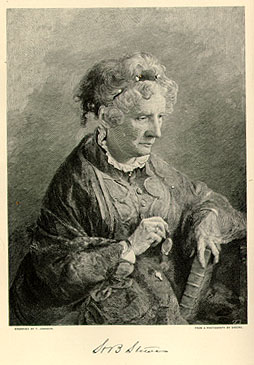
"Man! are you conscious of your immense responsibility?
You have deliberately undone the work of Harriet Beecher Stowe!"
| In the 1850s the southern strategy was vigorously to attack Uncle Tom's Cabin. In the 1880s and 1890s, however, southern writers made much subtler use of Stowe's novel in a rhetorical campaign to convince the white north that whites in the south had suffered more from the Civil War and Reconstruction than any blacks had ever suffered under slavery. Stowe was spoken of more respectfully, and her characters were brought back to "life" and employed in new fictions that were intended both to create a pro-slavery vision of the American past and to imply that the nation's racial future belonged in the hands of the descendants of slave-owners rather than the descendants of slaves, or any imaginable social, economic or political mixture of the two groups. |  |
 Frontispiece portrait of Stowe from October 1887 number of The Century Magazine |
By Joel Chandler Harris. [New York: D. Appleton and Co., 1880] By Gilbert Ireland (The Washington Post, 21 December 1883) By Walter B. Hill. (The Century Magazine 27, April 1884) By James Lane Allen. (The Century Magazine 34, October 1887) By Francis A. Shoup. (The Sewanee Review 2, November 1893) By Annie Jefferson Holland. [Austin: Published for the Author, 1892] By Eugenia J. Bacon. [New York: Continental Publishing Co., 1898] By Thomas Dixon, Jr. [New York: Doubleday, Page & Company, 1902] |
